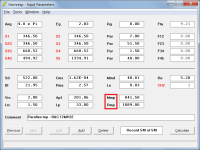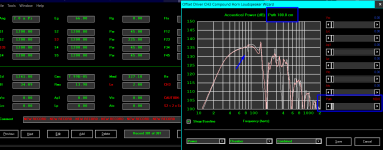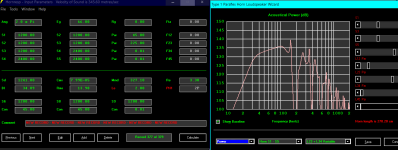Hi Marcelo,
Vrc and Lrc (RC) are being used to specify what is in effect a throat chamber, and Vtc and Atc (TC) are being used to specify what is in effect a rear chamber. The values shown do not appear to be consistent with the design. Vrc = 2 litres would seem to be perhaps too large for the throat chamber, and Vtc = 841.5 cubic centimetres would seem to be too small for the rear chamber.
Kind regards,
David
Vrc and Lrc (RC) are being used to specify what is in effect a throat chamber, and Vtc and Atc (TC) are being used to specify what is in effect a rear chamber. The values shown do not appear to be consistent with the design. Vrc = 2 litres would seem to be perhaps too large for the throat chamber, and Vtc = 841.5 cubic centimetres would seem to be too small for the rear chamber.
Kind regards,
David
Vrc and Lrc (RC) are being used to specify what is in effect a throat chamber, and Vtc and Atc (TC) are being used to specify what is in effect a rear chamber.
It was the best way I found to match the box design with current hornresp models available once it needs the chamber feeding a offset horn while the back the horn is in series and only CH2 has this configuration so it was needed to invert the chambers.
The values shown do not appear to be consistent with the design. Vrc = 2 litres would seem to be perhaps too large for the throat chamber, and Vtc = 841.5 cubic centimetres would seem to be too small for the rear chamber.
I will double check the numbers and finding for mistakes, I played around changing some number to see a sign to fix the dip without success.
Thanks to take a look.
I played around changing some number to see a sign to fix the dip without success.
For starters, try Vrc =1 litre and Vtc = 6000 cubic centimetres (6 litres) 🙂.
Hornresp Update 5500-230917
Hi Everyone,
BUG FIX
The bug identified in Post #13,942 has now been fixed.
Kind regards,
David
Hi Everyone,
BUG FIX
The bug identified in Post #13,942 has now been fixed.
Kind regards,
David
Hi,
I have to admit that I'm late to Hornresp, but I would ask...where do I start? I have downloaded the Windows based software. Where to next? Tutorials? Definition of variables?
I have two specific applications in mind:
1. Front horn, with an ~8 inch throat, for an Atelier Rullit AERO 10 FC (Field Coil) driver...perhaps a square horn, and as full range as possible, with possible augmentation for LF and HF..
2. A front horn/vented back chamber variant based on the Altec 816 cabinet using 815-8G drive units.
So, at the moment, I am not interested in tapped horns or horns for compression drivers, or back horns or other quirks, just the basics of using Hornresp.
Thanks for any suggested directions, and Best,
Robert Chambers
I have to admit that I'm late to Hornresp, but I would ask...where do I start? I have downloaded the Windows based software. Where to next? Tutorials? Definition of variables?
I have two specific applications in mind:
1. Front horn, with an ~8 inch throat, for an Atelier Rullit AERO 10 FC (Field Coil) driver...perhaps a square horn, and as full range as possible, with possible augmentation for LF and HF..
2. A front horn/vented back chamber variant based on the Altec 816 cabinet using 815-8G drive units.
So, at the moment, I am not interested in tapped horns or horns for compression drivers, or back horns or other quirks, just the basics of using Hornresp.
Thanks for any suggested directions, and Best,
Robert Chambers
Welcome Robert.
First order of business would be to look at the help menu. A lot of information is in there. The conventions of how you name things and use the different sections of Hornresp need to be understood in order to understand what we type in here for guidance.
Once you understand or at least begin to understand you will find a very large group of people here that will be willing to help you out.
First order of business would be to look at the help menu. A lot of information is in there. The conventions of how you name things and use the different sections of Hornresp need to be understood in order to understand what we type in here for guidance.
Once you understand or at least begin to understand you will find a very large group of people here that will be willing to help you out.
1. Front horn
Help > Input Wizard > Half space > Horn loaded > Front loaded > 1 segment > Exponential > Acoustical lining > Throat chamber
2. A front horn/vented back chamber
Help > Input Wizard > Half space > Horn loaded > Front loaded > 1 segment > Exponential > Vented > Throat chamber
Where to next? Tutorials? Definition of variables?
User manual: https://www.diyaudio.com/community/threads/hornresp-manual.383370/#post-6949474
Brian Steel has provided an example at his site. http://diysubwoofers.org/th/ as has Patrick here https://www.diyaudio.com/community/threads/an-improved-transmission-line-alignment.243483/. Maybe helpful for those with visual preference. A few YouTubers as well.
Hi, Thanks for the welcome and helpful replies. A couple of questions:
Front horn without a back chamber?
Square front horn?
Best, Robert
Front horn without a back chamber?
Square front horn?
Best, Robert
To remove the back chamber, set Vrc to zero. Since there will be sound radiated from the back of the driver, the resulting response will have some dips due to cancellations. You can look at the outputs from the horn and direct radiator individually by selecting from Tools -> Output -> <the result you want to see> when in the frequency response window.
The simulation models in Hornresp are one-dimensional, so you can't see the effects of cross sectional shape in simulation. (For bass horns, the effect is not very pronounced anyway.) But you can export the dimensions for it. When in the Schematic Diagram window, select File -> Export -> Horn Data, there you can select Rectangular Horn, and select how the expansion should be.
The simulation models in Hornresp are one-dimensional, so you can't see the effects of cross sectional shape in simulation. (For bass horns, the effect is not very pronounced anyway.) But you can export the dimensions for it. When in the Schematic Diagram window, select File -> Export -> Horn Data, there you can select Rectangular Horn, and select how the expansion should be.
Front horn without a back chamber?
Help > Input Wizard > Half space> Horn loaded > Back loaded > 1 segment > Exponential > Throat chamber > No throat adaptor
The discontinuity at 87.92 Hz seen in the CH3 design but not in the PH1 design is possibly due to the difference in the way that the two signals are combined. The CH3 discontinuity is sensitive to changes in L23 and L45 but the acoustic circuits of the CH3 and PH1 designs are just too complex to be able to identify a specific reason for the variation using manual analysis. Considering the difference in the topologies, I am pleasantly surprised that the results actually compare as favourably as they do.
I can't seem to get the APR model to work.
Here's an APR to sim, based on the calculations in the LDC, and I driver I use in many test boxes:
But when I put this information into Hornresp:

I get this...

Where am I going wrong...?
Here's an APR to sim, based on the calculations in the LDC, and I driver I use in many test boxes:
| Vas | = | 99.67 | litres |
| Qts | = | 0.30 | |
| Fs | = | 39 | Hz |
| Alpha | = | 1.25 | |
| H | = | 1.2 | |
| F3/Fs | = | 1.15 | |
| E | = | 0.4 | |
| Vb | = | 83.9 | litres |
| V1 | = | 33.6 | litres |
| V2 | = | 50.4 | litres |
| SP1 | = | 1140 | cm^2 |
| SP2 | = | 507 | cm^2 |
| Fb | = | 51.5 | Hz |
| F3 | = | 48.9 | Hz |
But when I put this information into Hornresp:
I get this...
Where am I going wrong...?
Where am I going wrong...?
The value of Mmp seems quite high at almost half a kilogram (431.75 gm) and the value of Rmp is definitely way too large at 350.00 newton.sec/m. Should Rmp perhaps have been 3.50 newton.sec/m? That would be a much more realistic value.
Hornresp Update 5500-230924
Hi Everyone,
BUG FIX 1
An incorrect progress bar message was displayed when the Output 1 or Output 2 response was being calculated for a CH2 or CH3 type loudspeaker. This has now been fixed.
BUG FIX 2
The Mma added mass slider in the augmented passive radiator loudspeaker wizard could not be scrolled back to zero once the setting exceeded 1000 grams. This has now been fixed.
Kind regards,
David
Hi Everyone,
BUG FIX 1
An incorrect progress bar message was displayed when the Output 1 or Output 2 response was being calculated for a CH2 or CH3 type loudspeaker. This has now been fixed.
BUG FIX 2
The Mma added mass slider in the augmented passive radiator loudspeaker wizard could not be scrolled back to zero once the setting exceeded 1000 grams. This has now been fixed.
Kind regards,
David
Hello David,
This weekend I played around with FreeCAD and Hornresp changing the model, some people call as SuperPlanar, from symmetric horn to asymmetric one. But my question is related to the feature present inside Hornresp simulation regarding masking Acoustic Power Output or unmasking it. I tried to read the help file but I didn't found mention inside it.
Do you mind to take a look in the attachments. The box is the same and I simulated it using CH model with two small differences as you will see.
1) Why masked result is different while using rear chamber?
2) What can we expect in the real world as SPL curve if we measure the box with RTA, will it be more close to masked result or to unmasked one?
3) Do you mind also to point why user have the option to choose between masked and unmasked simulation even if just one is more close to the reality?
Note: Maybe we are cheating the model here and once the chamber has a very big output and due to this the resonances will go out. If the vent was small compared to the chamber, as a classic Bass Reflex box, the vent could filter and mask resonances, maybe this is the reason, right?
Dimensions involved in the Chamber or H4 segment:
CSA = 29cm x 28cm = 812cm^2
Volume = 29cm x 28cm x 33cm = 26,976l
Best regards,
Marcelo
This weekend I played around with FreeCAD and Hornresp changing the model, some people call as SuperPlanar, from symmetric horn to asymmetric one. But my question is related to the feature present inside Hornresp simulation regarding masking Acoustic Power Output or unmasking it. I tried to read the help file but I didn't found mention inside it.
Do you mind to take a look in the attachments. The box is the same and I simulated it using CH model with two small differences as you will see.
1) Why masked result is different while using rear chamber?
2) What can we expect in the real world as SPL curve if we measure the box with RTA, will it be more close to masked result or to unmasked one?
3) Do you mind also to point why user have the option to choose between masked and unmasked simulation even if just one is more close to the reality?
Note: Maybe we are cheating the model here and once the chamber has a very big output and due to this the resonances will go out. If the vent was small compared to the chamber, as a classic Bass Reflex box, the vent could filter and mask resonances, maybe this is the reason, right?
Dimensions involved in the Chamber or H4 segment:
CSA = 29cm x 28cm = 812cm^2
Volume = 29cm x 28cm x 33cm = 26,976l
Best regards,
Marcelo
Attachments
Hi Marcelo,
The Options section in the Help file refers:
|Options
~~~~~
Sets the throat chamber and rear chamber resonance masking and default result window options.
If the 'resonances masked' option is selected then the throat and rear chamber air volumes are treated as simple acoustic compliances - there will be no reflections in the chambers to cause resonances. Changing the value of Lrc or Ltc (Vtc / Atc) makes no difference to the results.
It really depends on the amount of damping / losses in the actual system. In practice the result will probably lie somewhere between the two theoretical extremes. Unmasked results assume zero losses unless acoustical lining material is specified in the rear chamber.
The 'resonances masked' option was included in Hornresp so that results could be directly compared to those of other simulation programs, which in most cases assume chambers to be simple acoustic compliances.
If the 'resonances not masked' option is being used, then the resonances can in effect be removed by making Lrc and Ltc (Vtc / Atc) very small.
The results for your two examples will be different if the 'resonances masked' option is selected, but they will be effectively the same if the 'resonances not masked' option is being used.
The 'resonances masked' and 'resonances not masked' results for your second (MOD) example will be almost identical because there is no rear chamber, and Ltc for the throat chamber is relatively small at 1.44 cm, meaning any resonances will be minor and at high frequencies.
Kind regards,
David
But my question is related to the feature present inside Hornresp simulation regarding masking Acoustic Power Output or unmasking it. I tried to read the help file but I didn't found mention inside it.
The Options section in the Help file refers:
|Options
~~~~~
Sets the throat chamber and rear chamber resonance masking and default result window options.
1) Why masked result is different while using rear chamber?
If the 'resonances masked' option is selected then the throat and rear chamber air volumes are treated as simple acoustic compliances - there will be no reflections in the chambers to cause resonances. Changing the value of Lrc or Ltc (Vtc / Atc) makes no difference to the results.
2) What can we expect in the real world as SPL curve if we measure the box with RTA, will it be more close to masked result or to unmasked one?
It really depends on the amount of damping / losses in the actual system. In practice the result will probably lie somewhere between the two theoretical extremes. Unmasked results assume zero losses unless acoustical lining material is specified in the rear chamber.
3) Do you mind also to point why user have the option to choose between masked and unmasked simulation even if just one is more close to the reality?
The 'resonances masked' option was included in Hornresp so that results could be directly compared to those of other simulation programs, which in most cases assume chambers to be simple acoustic compliances.
Note: Maybe we are cheating the model here and once the chamber has a very big output and due to this the resonances will go out. If the vent was small compared to the chamber, as a classic Bass Reflex box, the vent could filter and mask resonances, maybe this is the reason, right?
If the 'resonances not masked' option is being used, then the resonances can in effect be removed by making Lrc and Ltc (Vtc / Atc) very small.
The results for your two examples will be different if the 'resonances masked' option is selected, but they will be effectively the same if the 'resonances not masked' option is being used.
The 'resonances masked' and 'resonances not masked' results for your second (MOD) example will be almost identical because there is no rear chamber, and Ltc for the throat chamber is relatively small at 1.44 cm, meaning any resonances will be minor and at high frequencies.
Kind regards,
David
- Home
- Loudspeakers
- Subwoofers
- Hornresp


